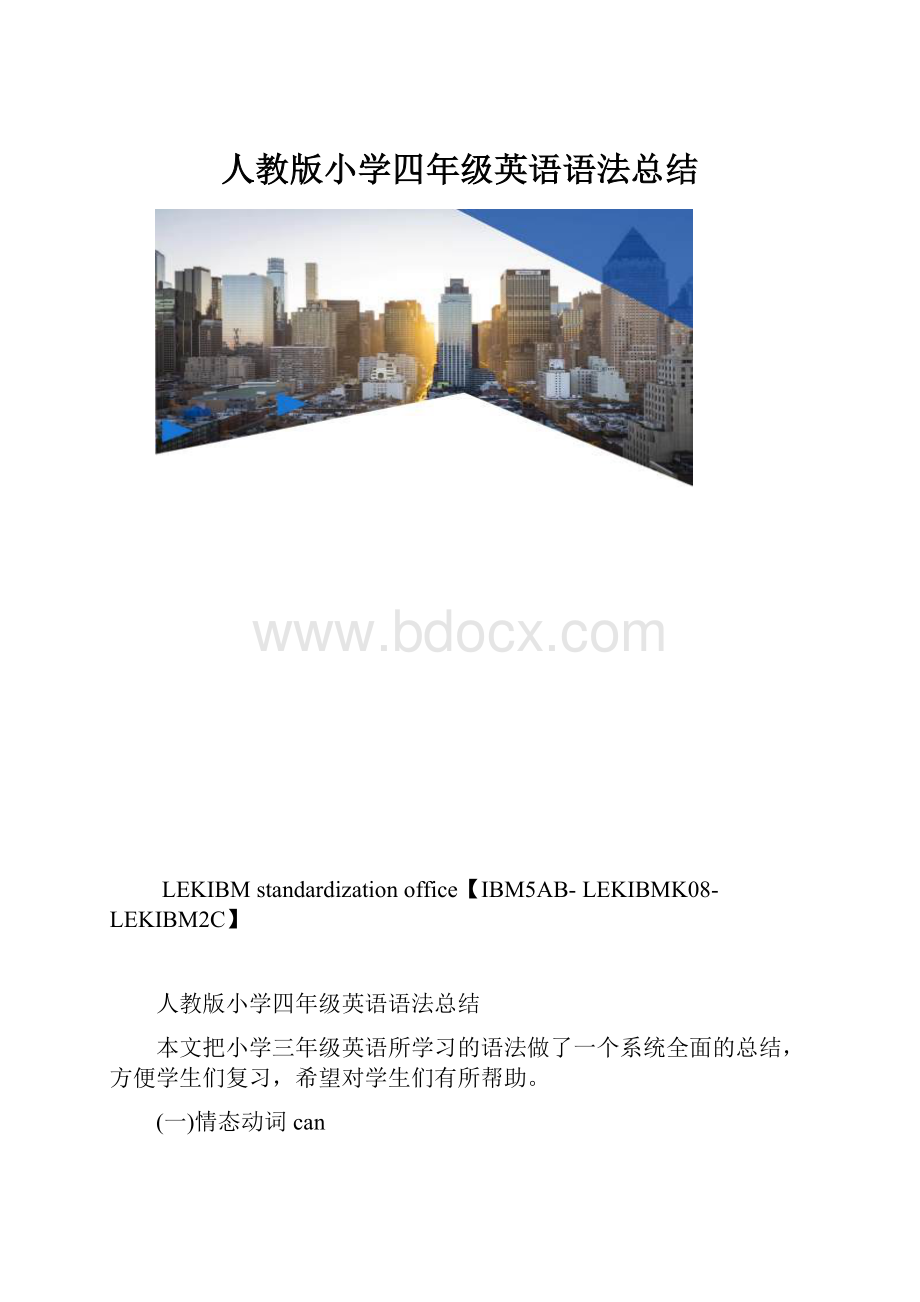人教版小学四年级英语语法总结.docx
《人教版小学四年级英语语法总结.docx》由会员分享,可在线阅读,更多相关《人教版小学四年级英语语法总结.docx(11页珍藏版)》请在冰豆网上搜索。

人教版小学四年级英语语法总结
LEKIBMstandardizationoffice【IBM5AB-LEKIBMK08-LEKIBM2C】
人教版小学四年级英语语法总结
本文把小学三年级英语所学习的语法做了一个系统全面的总结,方便学生们复习,希望对学生们有所帮助。
(一)情态动词can
can在英语中有一个特殊的名字,叫做情态动词,表示“能够”,“会”,“能力”后面要跟着表示动作的动词。
没有时态和人称的变化。
表示不能做什么的时候,后面加上not为cannot,或者缩写为can’t。
问别人“能…吗”
要把can放在句子前面,首字母要大写,句尾别忘加上问号。
例句:
—Icancandraw. —Shecancanplay.
—Wecantouch.Theycanrun. —Ican’tcan’tsee.
—Shecan’tcan’thearacar. —Wecan’thearanaeroplane.
—CanyouhearadogCanhehearabus—CanLucywriteCanyoudoit
将下面各组词组成句子
(an, aeroplane, hear, Lucy, can)
2._____________________(not, he, dance, can)
(you, can, see, what)
(can, see, not, we, you)
.(I, can, help, you)
(I, can, do, what)
(you, can, hear me)
(you, can, dance)
(二)人称代词所属格
注意:
主格作主语,其中she指带代国家,it可指代天气时间等。
宾格作宾语,介词宾语,表语。
动词后面用人称宾格
形容词性物主代词作定语。
名词性物主代词作主语,宾语,介词宾语,表语书信yours…
表示----的,这样的词我们也学习很多了,你能想出来吗?
记住这个小口诀就很容易了:
我的my,你的your,他的his、她的her.出下列人称代词的所属格形式
I________ you_________ he______________ She_________ it____________ we_____________ You_________ they_________
二.用合适的人称代词填空
(1)ThisisBen. Thisis_______bicycle.
(2)IamKitty. ______bagisblue
(3)She’sAlice. That’s_____umbrella.
(4)YouareMrLi. ______carisblack.
(5)Isthis______hat?
Yes,it’smyhat.
(6)That’smy’s_____coat.
(7)Where’s______scarf?
Hereyouare.
(8)He’sMrWang. _____glovesarenew.
三.翻译下列词组
1.你的名字_____________ 2.我们班___________
3.他的小弟弟____________ 4.我祖母___________
5.它的尾巴______________ 6.我的鞋____________
7.她的围巾________________ 8.我的衬衫_________
9.他们的老师______________ 10.玛丽的雨伞_________
四.用下列单词组句
(my,is,name,Tom)
(is,miss,Gao,,our,friend)
(iswhat,yournumber,telephone)
(mother,your,ateacher,is)
(who’s,cap,it,is)
答案:
一.I(my) you(your) he(his) she(her) it(its) We(our) you(your) they(their)
三.name class 3.hislittlebrother grandmother tail shoes scarf shirt teacher 10.Mary’sumbrella
四.nameisTom. Gaoisourfriend ’syourtelephonenumber?
yourmotherateacher?
’scapisit?
(三)介词、连词和感叹词
1.介词:
介词是一种虚词,不能单独使用,必须在介词后面加上个名词或代词使用,作句子成份。
介词后面的名词(或相当于名词的其它词)叫做介词的宾语。
介词和介词宾语合称为介词短语。
介词短语在句中可作壮语、定语或表语。
介词如:
in在…里面on在…上面under在…下面等。
intheclassroom inthetree inthehall
ontheroad onthedesk onthefloor
underthetable underthebed underthechair
2.连词:
连词是用来连接词与词、短语与短语、句子与句子等的词叫连词。
连词是一种虚词,在句子中不能单独作句子成分。
连词分两类:
一类叫等立连词,另一类叫从属连词。
(1).等立连词是用来连接同等的词、词组和分句的。
等立连词有许多
我们现在只学到了and和but,其他的以后学到再介绍。
如:
AandB;blueandwhite;anappleandabanana;acarandabus;LucyandBen;BenandKitty;
Thisisalorryandthat’sadrill.
Ilikedollsandyoulikerobots.
(2).从属连词是用来引起从句的、从属连词又分为
1)引起名词性从句的连接词,如:
if,that等。
2)引起壮语从句的连接词,如:
when,after,befare等。
以后会逐渐学到再介绍。
3.感叹词:
表示说话人的某种感情(惊讶,高兴,痛苦等)的词叫感叹词。
感叹词后常用感叹号。
常用的感叹词有:
oh(表示惊奇或痛苦),ah(表示惊奇或满意),hello(常被用来打招呼相当于汉语的“喂!
”),well(表示惊讶,无奈)
如:
youMary?
练习:
翻译下列词组
1.在桌子上面 2.在树下面
3.在椅子上面 4.在盒子里面
5.在黑板上 6.在书里
7.在脸上 8.在公共汽车上
9.一只猫和一只狗. 10.又小又胖
答案:
1.onthedesk 2.underthetree 3.onthechair 4.inthebox 5.ontheblackboard 6.inthebook 7.ontheface 8.onthebus 9.acatandadog 10.smallandfat
(4)单数句和复数句:
(5) 口诀:
单数句子变,变化规则要记住。
名词代词要变化,am,is要变are。
(6) this,that变成啥,these,those来替它。
he,she,it要变啥,全部变they不用怕。
(7) I要变we莫落下,名词后面把s/es加。
名前冠词去掉它,其余成分原样加。
(8) 具体注意下面的六要素:
(9) 1.单数主格人称代词要变成相应的复数主格人称代词,即I→we;you→you;she,he,it→they。
如:
Sheisagirl.→Theyaregirls.
(10) 2.am,is要变为are。
如:
I‘mastudent.→Wearestudents.
(11) 3.不定冠词a,an要去掉。
如:
Heisaboy.→Theyareboys.
(12) 4.普通单数名词要变为复数形式。
如:
Itisacat.→Theyarecats.
(13) 5.指示代词this,that要变为these,those。
如:
Thisisabook.→Thesearebooks.
(14) 6.man,woman作定语修饰可数名词时,要在”数”上与被修饰名词保持一致。
但其他名词修饰名词表示”性质”时,不作变化。
如:
(15) Heisamandoctor.→Theyaremendoctors.
(16)
(17) Thisisanappletree.→Theyareappletrees.
(18)
(19) 单复数相互转换,每空一词(含缩写)。
(20) 1.Thewomanisanurse.(改为复数句)
(21) The___________________________.
(22)
(23) 2.Therearesomeoldcars.(改为单数句)
(24) There______________old_______.
(25)
(26) 3.Hehasanewbook.(改为复数句)
(27) ____________new_______.
(28)
(29) 4.Aretheseyourchicks(
(30)改为单数句)
(31) ____________your_______
(32)
(33)
(34) 5.Isthereasheepintheplayground(
(35)改为复数句)
(36) ____there________intheplayground?
(37)
(38) (五)一般疑问句及特殊疑问句
(39) 句子基本是:
简单陈述句,由简单陈述句转变成肯定句,否定句,疑问句。
疑问句是用来提出问题。
英语中有四种疑问句:
一般疑问句、特殊疑问句、选择疑问句和反意疑问句。
我们现在已经接触到了前两种疑问句。
后两种疑问句以后我们还会学到.
(40) 一.一般疑问句:
(41) 英语中要用yes和no来回答的疑问句叫一般疑问句。
如:
(42) 1)Isithot
(43)Yes,itis.\No,itisn’t.——be动词引导
(44)
(45) 2)Isitacar
(46)Yes,itis.\No,itisn’t.——be动词引导
(47)
(48) 3)Isthisyourruler
(49)Yes,itis.\No,itisn’t.——be动词引导
(50)
(51) 4)Doyoulikebananas—
(52)—含实义动词
(53)
(54) Yes,Ilikebananas.\No,Idon’tlikebananas.
(55)
(56) 5)CanMinghearadrill—
(57)—含情态动词
(58)
(59) Yes,Mingcanhearadrill.\No,Mingcan’thearadrill.
(60)
(61) 二.陈述句(肯定句,否定句,一般疑问句)的转变规律:
(62) 1.肯定句:
2.否定句:
3.一般疑问句及肯否定回答
(63) 1)主语+be动词+….1)主语+be动词+not+….1)be动词+主语+…
(64)
(65) Yes,主语+be动词./No,主语+be动词+not.
(66) Iamateacher. Iamnotayouateacher?
(67) --Yes,Iam./No,Iamnot.
(68) Mymotheristhin. Mymotherisnot/isn’tyourmotherthin?
(69) --Yes,sheis./No,sheisn’t.
(70) Theyareinsects. Theyarenot/aren’ttheyinsects?
(71) --Yes.theyare./No,theyaren’t.
(72) 2)主语+情态动词can+…2)主语+情态动词can+not+….2)情态动词can+主语+…
(73)
(74) Yes,主语+情态动词can/
(75) No,主语+情态动词can+not
(76) Hecanjump. Hecannot/can’hejump?
(77) --Yes,hecan./No,hecan’t.
(78) 3)助动词do/does+主语+….动词原形+….动词原形?
(79) Yes,主语+助动词do/does.
(80) No,主语+助动词do/does+not.
(81) Helikestoeatapples. Hedoesn’tliketoeatapples. Doesheliketoeatapples?
(82) Yes,hedoes./No,hedoesn’t.
二.祈使句:
表示请求、命令、建议或劝告等的句子叫祈使句,主语you常省略。
1、肯定形式:
一般以动词原形开头。
Openthedoor,please.
2、否定形式:
在句首谓语动词前加Don‘t。
Don‘tbelateforclass.
三特殊疑问句(又叫wh-question)
用特殊疑问词来提出问题的疑问句叫作特殊疑问句。
特殊疑问词一般要放在句首。
常用的疑问词有whatwho,whichhow等这些词都以wh开头(包括how)所以也叫作wh-question。
特殊疑问句要求回答具体内容。
不能用yes或no回答。
结构:
疑问词+一般疑问句。
回答不能用yes/no(或相当于yes/no)回答的问句。
答句的句式同肯定句句式:
如:
Whatcanyousee
Icanseeacat.
Whatcanyouhear
Icanhearabus.
Whatcanyoudo
Icansinganddance.
Whatisit
It’sapanda.
Whatdoyoulike
Ilikeplayingfootball
Howoldareyou
I’mten.
一.将下列句子变成一般疑问句
1MrWangisthirsty。
elephent’searsarelong。
3.Welikebirds。
arehismother。
cansinganddance.
二将下列每组词各组成一句特殊疑问句
1.(youarehow)._______________
.
2.(oldhowBenis)_________________
iswhatyourshirt____________
4.(canseewhattheonyoudesk)____
5.(likewhatdoyou)________________
答案:
一.1.IsMrWangthirsty 2.Aretheelephent’searslong 3.Doyoulikebirds .Areyouhismother?
yousinganddance?
二.1.Howareyou?
oldisBen
colourisyourshirt?
canyouseeonthedesk?
doyoulike?